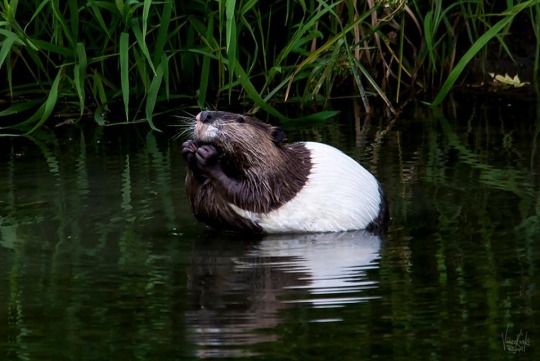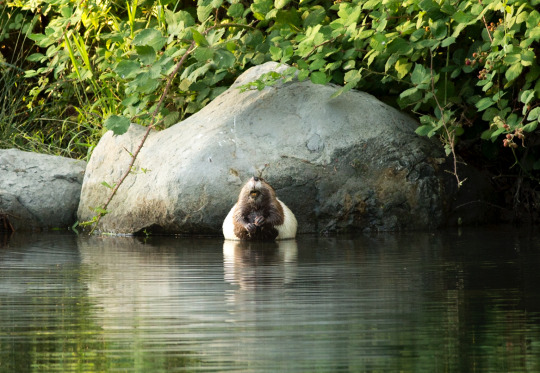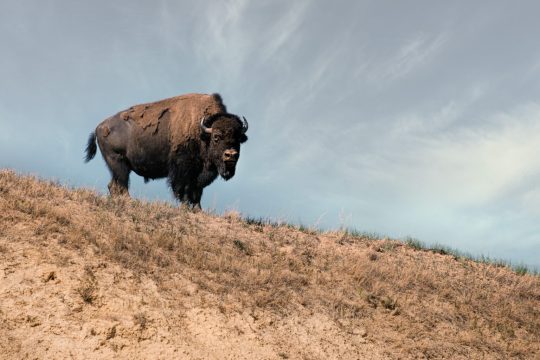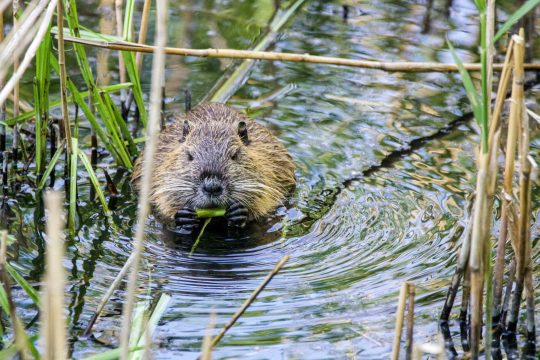#Beaver
Explore tagged Tumblr posts
Text
https://english.radio.cz/beavers-build-planned-dams-protected-landscape-area-while-local-officials-still-8841536

A beaver colony in the Brdy region has gained overnight fame by building several dams in the Brdy protected landscape area, creating a natural wetland exactly where it was needed. It saved the local authorities 30 million crowns, and has the public cracking jokes about public administration and red tape.
The administration of the Brdy protected landscape area, which had gained approval for the 30 million crown project, was dealing with red tape and seeking the respective building permits from the Vltava River Basin authorities when the dam project was completed almost overnight by a local colony of beavers.
They could not have chosen their location better –erecting the dams on a bypass gully that was built by soldiers in the former military base years ago, so as to drain the area. The revitalization project drafted by environmentalists was supposed to remedy this. Bohumil Fišer, head of the Brdy Protected Landscape Area Administration says Nature took its course and the beavers created the necessary biotope conditions practically overnight.
#good news#beavers#brdy#beaver#ecosystem engineers#environmentalism#science#environment#nature#animals#Czech Republic
23K notes
·
View notes
Text
He knows how to turn on his own and everything😂
Source
10K notes
·
View notes
Text
"England is celebrating the first pair of beaver kits born in the country since they were reintroduced back into the country’s north last year.
Landscape managers in England are beside themselves with surprise over the changes brought about by a single year of beaver residency at the Wallington Estate in Northumberland—with dams, mudflats, and ponds just appearing out of nowhere across the landscape.
Released into a 25-acre habitat on the estate last year, the four beavers at Wallington are part of a series of beaver returns that took place across the UK starting in 2021 in Dorset. Last year, GNN reported that Hasel and Chompy were released into the 925-acre Ewhurst Estate in Hampshire in January 2023, and the beavers that have now reproduced established their home in Wallington in July.
“Beavers are changing the landscape all the time, you don’t really know what is coming next and that probably freaks some people out,” said Paul Hewitt, the countryside manager for the trust at Wallington. “They are basically river anarchists.”
“This time last year I don’t think I fully knew what beavers did. Now I understand a lot more and it is a massive lightbulb moment. It is such a magical animal in terms of what it does.”
It’s believed that the only animal which alters the natural environment to the same extent as humans is the beaver. Their constant felling of trees to construct dams causes creeks to build up into pools that spill out during rainfall across the land, cutting numerous other small channels into the soil that distribute water in multiple directions.
Hewitt says that in Wallington this has translated to a frantic return of glorious wildlife like kingfishers, herons, and bats.
Recently the mature pair of beavers mated and produced a kit, though its sex is not yet known because beavers don’t have external genitalia.
These beaver reintroductions have led to a raft of beaver sightings around the country. Those at the National Trust working to rewild the beaver back into Great Britain hope the recovery of the landscape will convince authorities to permit further reintroductions to bigger areas."
-via Good News Network, July 16, 2024
#beaver#beavers#wild animals#rewilding#ecosystem#ecology#ecosystem restoration#conservation#climate action#biodiversity#good news#hope
4K notes
·
View notes
Text
When you go to the store for "just one thing"
A porcelain figurine - one of a kind, handmade.



#beaver#ceramics#cute#artoftheday#handmade#art#porcelain#pottery#vegetables#groceries#adorableanimals
32K notes
·
View notes
Text

2K notes
·
View notes
Text

9K notes
·
View notes
Text

Bucky Beaver from SHIPWRECKED 64
926 notes
·
View notes
Text

John Kaufmann's 1968 wraparound cover to Andre Norton's Fur Magic
404 notes
·
View notes
Text

#youtube#redlettermedia#red letter media#rich evans#jay bauman#gorilla interrupted#half in the bag#mike stoklasa#best of the worst#jack packard#beaver#beavers#hundreds of beavers#karlie kloss
1K notes
·
View notes
Text


Piebald American beaver (Castor canadensis) [x]
6K notes
·
View notes
Text

credit
2K notes
·
View notes
Text
In 2022, something happened in Britain for the first time in 6,000 years. Deep in the Kent countryside, a wild European bison calf was born as part of the Wilder Blean rewilding project. The last time wild European bison roamed Britain’s landscapes was after the last Ice Age, some 10,000 years ago, so it’s no wonder the calf’s arrival caused a stir. European bison were once a common sight across most of Europe. As the largest herbivore to roam the continent, European bison could be found from France all the way to the tip of the Black Sea in the Ukraine. The fossil record tells us that European bison have been roving the continent since the end of the Paleolithic Ice Age, with the earliest fossils dating back to 9,000 BC.
Now, bison are bouncing back. They have experienced a 166-fold increase in their population in the last 50 years. And these rates of return are not solely the reserve of the mighty bison. Other wild European mammals are also making a roaring comeback, and the speed of their resurgence suggests that wider, rapid natural regeneration is possible with multiple ecological, and therefore human benefits.

From 1960 to 2016, Eurasian beaver (Castor fiber) populations have ballooned 167-fold, from just a few thousand at the start of the 20th century to over 1.2 million wild beavers today. Grey seal populations have also grown by 6,273 percent and the population of Alpine ibex has risen by 417 percent. Eurasian badger populations have doubled, while Eurasian otter populations have tripled.
While these impressive rates of recovery are not reflected across all of Europe’s 250 wild mammal species, they do provide some evidence-based hope that wild mammals can once again flourish across Europe’s diverse and varied landscapes with the right support and policies in place.
The big picture
... Over the last 50 years the fate of some wild mammals across Europe has shifted. Some populations have experienced a rapid and dramatic increase over the last half century, reversing millenia of decline and offering fresh hope that nature can recover – if it’s given the chance.
Brown bear numbers have risen by an average of 44 percent between 1960 and 2016, while the Iberian lynx has seen its population grow by 252 percent. Humpback whales have seen their numbers rise by 37 percent between 1986 to 2016, while the pine marten – a natural predator to the invasive grey squirrel – has seen its population grow by 21 percent from 1986 to 2016. Some reptile species, such as the loggerhead turtle, have seen its numbers grow by 68 percent over the last 40 years.
The most impressive bounce backs, however, are among the beaver and bison – two species that play vital roles within ecosystems. Both beaver and bison populations have seen 167-fold increases over the last 50 years. These mammals help support a rich mosaic of habitats and biodiversity. Wild bison, for instance, trample and wallow in the soil and sand to create niche habitats for plants, insects and lizards, while also playing an important role in the dispersal of seeds.
Context and background
The impressive recovery rates over the past 50 years have been possible due to a shifting cultural and economic context. Alongside this, there is a growing scientific consensus of the importance of small and large mammals for sustaining biodiversity and helping ecosystems flourish. The sheer diversity of mammals, both in terms of their morphology and their roles within ecosystems, is testimony to the functions they perform. From the tiny bumblebee bat, which weighs just two grams, to behemoth blue whales, weighing in at 150,000 kilograms, mammals really do come in all shapes and sizes.

Wild mammals play a variety of leading roles within an ecosystem, from dispersing seeds, pollinating plants and regulating insect populations, to reducing disease transmission and creating niche habitats for other species. The European bison reintroduced to Kent in the UK have already started clearing paths through undergrowth, ripping the bark off trees, and wallowing around in the mud to make space for seeds and other habitats – natural processes that humans would struggle to replicate. Bison and other large herbivores are often labelled ‘ecosystem engineers’ for this very reason – they shape and manage the land they reside on.
Some species of mammals – such as the magical beaver – are considered keystone species due to their ability to shape the ecosystems around them, creating entirely new habitats through building dams where fish, birds and all manner of species can thrive. Other mammals, like bats, act as indicators of healthy and functioning ecosystems. Between 1974 and 2016, Geoffroy’s bat populations have increased 53-fold across Europe.
Wild mammals also have a role to play in reducing the damage and destruction wrought by climate breakdown. In the temperate climate of Europe, large mammals have been proven to reduce the risk of forest and wildfires by creating gaps in vegetation through grazing and trampling. In the summer of 2022, wildfires ravaged Europe, burning the second-largest area on record. As global temperatures continue to rise, wildfires will increase in their frequency and severity. Bolstering the population of large mammals could provide a useful tool in the fight against fires alongside deep and immediate cuts to emissions...
What’s more, the grazing of wild mammals can also help retain the carbon stability of soil over long periods of time. Soil contains vast amounts of carbon – more than all plants and the atmosphere combined – which makes ensuring its stability important for both climate efforts and environmental conservation. Mammals like the alpine ibex, which have seen their numbers grow by 417 percent from 1975 to 2016, are highly effective at stabilising soil carbon within grazing ecosystems.
-via Rapid Transition Alliance, March 29, 2023
#beaver#bison#mammal#ecosystem#ecology#endangered species#europe#united kingdom#kent#wildfires#rewilding#ecosystem restoration#good news#hope#hope posting
2K notes
·
View notes
Text


Mama Beaver is back from the Groceries !
588 notes
·
View notes

